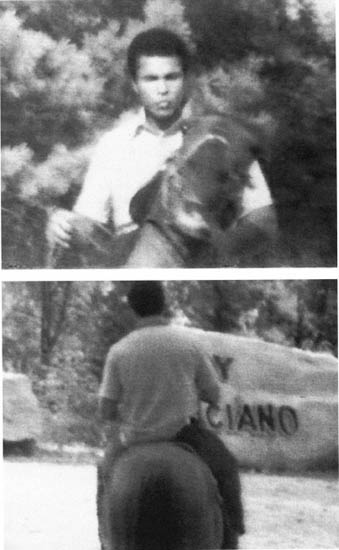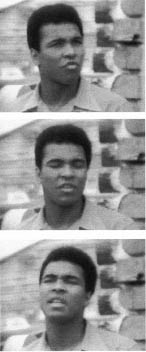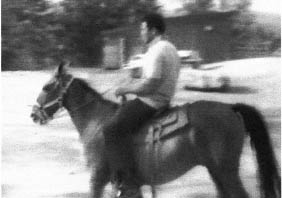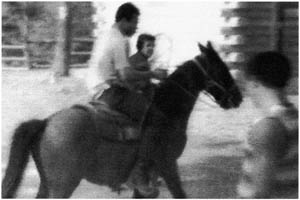
HIGHWAY 61
REVISITED

HIGHWAY 61 REVISITED
THIRTY MILES OUTSIDE Reading in northern Pennsylvania, Highway 61 winds through a series of small towns nestled among pine forests and rolling fields. Tractors from local farms rumble along the edge of a four-lane road lined by a series of clapboard ice cream stands, scattered garages and battered advertisements until, two miles past the Deer Lake Motel, a large white sign with red letters points across the road up a steep hill to ‘ALI’S CAMP’.
Every Sunday, a number of tourists turn off Highway 61 and follow the dirt drive up a wooded hill. Halfway up, the track turns sharply to the left, then right; around the corner, the driver catches sight of a large parking lot cut into the hillside on his left and, nailed to the trunk of an oak tree on his right, another red sign reading ‘WELCOME TO ALI’S CAMP’ points down a sharp incline towards a group of log cabins.
The driveway grows narrow, bordered on the right by a series of similar boulders, each bearing the name of a great boxer: Jersey Joe Walcott, Sugar Ray Robinson, Rocky Marciano, Archie Moore, Kid Gavilan …
Parking, the visitor gets out of his car, crosses the drive and follows the sign down toward the cabins. He glances to his right at a small red stable and corral in which two workhorses are grazing. On his left, in front of the first log cabin, he sees a black boulder six feet long, four feet high, with the name JOE LOUIS painted across it in large white capital letters. As it leads around to the right of the log cabin, the driveway grows narrow, bordered on the right by a series of similar boulders, each bearing the name of a great boxer: Jersey Joe Walcott, Sugar Ray Robinson, Rocky Marciano, Archie Moore, Kid Gavilan … Beyond the rocks, the ground falls off in steep, thickly wooded slopes. The walls of the long low cabin border the left side of the drive until, rounding the corner of the cabin, the visitor enters a large rectangular courtyard overlooking the highway and surrounding hills.


The driveway picks up again diagonally across the courtyard, climbing – between another long log cabin to the left and a smaller cabin with a chimney to the right – up past a fourth cabin set into the hill. It ends in front of a chicken coop on the border of trees which rise to the hilltop. As he stands on the edge of the courtyard, the visitor can see in front of him, in the middle of the yard, an enormous stone fireplace. To the left of the small log cabin, he notices a massive iron bell hanging from two dark poles jutting twenty feet into the clear country air.
The second, larger log cabin on his left has another sign beside the door, and he walks closer to examine it, reading: CORETTA’S KITCHEN. He turns back and looks around. Long wooden benches hewn from massive tree trunks are set around the courtyard beside an early American carriage and the frame of a large covered wagon.
On the wall to his left, a life-size cardboard black and white photograph depicts a slight, sixteen-year-old, Golden Gloves champion Cassius Clay in a boxing pose.
Just then a dark green Rolls Royce appears silently around the corner of the first cabin. A dapper black man climbs out and, greeting the visitor, begins to lead him around the camp, pointing out the sights. They enter the first log cabin. The visitor looks around a small, low-ceilinged room with a day-bed propped against the wall on his right. To his left, a door leads into a large shower-room. Across the room, through another door, he can see a large, immaculate, modern gymnasium.

Stepping into the gym, he notices numerous memorabilia of Muhammad Ali’s life and career. On the wall to his left, a life-size cardboard black and white photograph depicts a slight, sixteen-year-old, Golden Gloves champion Cassius Clay in a boxing pose. Past the photographs is a full-length mirror, then more photographs of Ali in action, taken from the covers of Time, Life, Newsweek, Sports Illustrated, and many other magazines. Across the gym, another large portrait hangs beside a huge pair of golden gloves with ‘Floyd Patterson’ inscribed in black ink across the wrists. In the center of the gym is a full scale championship ring, with a heavy bag hanging from the ceiling in front of it and a second light bag positioned near the right wall.
After a minute the guide turns and, walking back through the small sleeping room, leads the visitor out on to the courtyard again, taking him toward the cabin marked CORETTA’S KITCHEN. Inside is a large, cafeteria-style room, with three long tables on the right, two long stoves, a double sink, two large refrigerators, cupboards, a chopping table, and two tall aluminium coffee machines on the left. On the wall opposite the door is a fourth sign, again painted in red letters, announcing:

Rules of My KYTCHEN

1 PLEASE TO KEEP OUTE except on express permission of cooke
2 COOKE shall designate pot scourers pan polishers peelers scrapers and COOKE has supreme AUTHORITY AT ALL TIMES.
3 NO REMARKS AT ALL WILL BE TOLORATED concerning the blackening of toast the weakness of soupe or the strength of the garlic stewe.
4 What goes in stews & soups is NOBODY’S dam business.
5 If you MUST sticke your finger in something stick it in the garbage disposal.
6 DON’T CRITICIZE the coffee you may be olde and weak yourself someday.
7 ANYONE bringinge guests in for dinner without PRIOR NOTICE will be awarded thwacks on skull with sharpe object.
8 PLEASE WAITE Rome wasn’t burnt in a day and it takes awhile to burne the ROASTE.
9 IF YOU MUST pinche somethinge in this KYTCHEN PINCHIE the COOKE!
10 this is my kitchen if you don’t believe if START SOMETHING.
Leaving the kitchen, the visitor is led across to the smaller log cabin. A screen door opens on to living quarters furnished in early American style with replicas of Jesse James and Sam and Belle Star ‘Wanted’ posters from the Wild West decorating its rough-hewn walls. To the right of the door, in front of a picture window overlooking the highway and hills, a stone well provides cold spring water. Across the room, a large fireplace; to the left, a brass double bed in the corner. In the center of the room, behind a small wooden table and gas lamp, two rocking chairs suitable for late night reading sit next to a Franklin stove.
This is the cabin in which Muhammad Ali lives while he is training. For months he leads a Spartan existence – rising at 5:00 a.m. and ringing the bell to wake his eleven man crew. Breakfast is at eight, followed by a four mile run through the woods and fields, a workout in the gym before lunch at 1:00 p.m. Then a nap followed by business and conversation until 3:30, when he dons his sweatsuit and heads to the gym for another workout or sparring session. Supper is at 6:00, and sometimes he screens a video film of one of his fights in the evening, before lights out at 11:00. Lights out, that is, for the rest of the camp. For at eleven o’clock in the middle of the hills, with a gas lamp propped by his elbow, Muhammad Ali sits alone, reading, writing, studying, preparing his thoughts for the future.